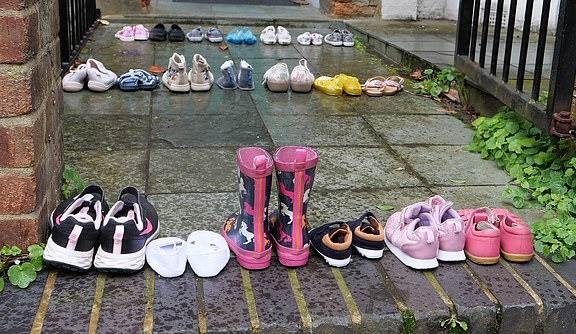As Gaza continues to endure unimaginable suffering under siege, testimonies from international healthcare workers, recently presented to the UK’s International Development Committee (IDC), have brought disturbing new evidence to light…
In the committee’s hearing this week, retired British transplant surgeon Professor Nizam Mamode joined representatives from the United Nations Relief and Works Agency (UNWRA) and other aid organizations to relay chilling accounts of what they witnessed. In a damning indictment of the conflict’s toll on Gaza’s civilian population, healthcare workers described the devastation of medical facilities, deliberate targeting of civilians, and a humanitarian disaster escalating by the day.
Professor Nizam Mamode, a seasoned transplant surgeon with a career spanning dangerous conflict zones, recently returned from Gaza’s Nasser Hospital with a new level of horror etched into his memory.
Fighting back tears, he said: “I’ve never seen anything like Gaza,” he said, comparing it even to his work in Rwanda during the genocide. His testimony corroborated reports from a growing chorus of international doctors, nurses, and paramedics who have witnessed the suffering firsthand and who now stand in solidarity to bring these stories to light.
A recurring and deeply disturbing pattern emerged: healthcare workers in Gaza report an unprecedented targeting of civilians, especially children. According to Mamode and dozens of medical volunteers, Israeli forces have repeatedly used quadcopters, or small drones, to “pick off” survivors after bombings.
“This was not an isolated incident but something that happened day after day,” Mamode told the committee. Reports detail how drones would hover over injured children and civilians lying amidst the debris of airstrikes, firing fatal shots. Some children suffered sniper injuries to the head and chest, areas meant to incapacitate or kill.
This deliberate targeting was witnessed by American trauma surgeon Dr. Feroze Sidhwa, who spent two weeks at the European Hospital in Khan Younis, Gaza. “Nearly every day, I treated a young child with a gunshot wound to the head or chest,” Sidhwa recounted. His report aligns with statements from 65 health workers surveyed, of whom 44 reported seeing preteen children with similar fatal injuries.
“I saw them every day, and it wasn’t random,” noted Dr. Mimi Syed, who also worked in Khan Younis. Other medical personnel, like Dr. Khawaja Ikram from Texas, recounted cases of young children brought in with single bullet wounds, including one three-year-old and one five-year-old who had been shot in the head. Dr. Mark Perlmutter, an orthopedic surgeon from North Carolina, told of the wrenching experience of treating multiple children with “high-velocity bullet wounds in both the head and chest.”

Children are shot in the head by Israeli snipers in Gaza
A Healthcare System on the Brink
The health crisis in Gaza extends beyond physical injuries. Due to restricted access to medical supplies, healthcare workers often operate under extreme conditions with little to no resources. Doctors report performing surgeries without gloves or sterile instruments, cleaning wounds with reused cotton, and facing the constant threat of infection due to a lack of antibiotics and basic hygiene supplies.
“For the first time in my career, I saw fly maggots coming out of wounds,” said Dr. Mohammed Al-Jaghbeer, a pulmonary and critical care doctor from Ohio. Flies, poor sanitation, and resistant bacteria became routine challenges.
In her testimony, Professor Mamode shared a view echoed by the IDC chair Sarah Champion: that Gaza’s so-called “safe zones” are neither safe nor humanitarian. Over one million people are crammed into these areas with only plastic sheeting for shelter, and medical facilities are crumbling under the strain. The conditions are so severe that even daily resources like soap and antiseptic are rare. American nurse Laura Swoboda, who worked with children in Gaza, reported: “Nearly every wound I saw was infected. I saw more maggots in one day than I had in my entire career as a wound specialist.”
Consequences of Malnutrition and Infant Deaths
In addition to physical trauma, Gaza’s children are facing severe malnutrition and psychological distress. Doctors reported treating children with signs of chronic malnutrition, dehydration, and infections brought on by starvation and exposure. Many mothers, unable to eat or drink enough, can no longer produce milk, leaving their newborns dangerously undernourished. Pediatrician Dr. Aman Odeh, who worked in a neonatal ICU, described daily infant deaths due to preventable complications like dehydration, starvation, and infection.
The psychological toll on Gaza’s children is likewise devastating. Many exhibit signs of post-traumatic stress, with healthcare workers noting frequent instances of dissociation and extreme emotional distress. Some children, having lost all family members, even express suicidal thoughts, asking, “Why wasn’t I killed too?” Dr. Tanya Haj-Hassan, a pediatric critical care doctor, recounted the heartbreaking case of a child who voiced a desire to join his family “in heaven.”
Chair’s Response and International Accountability
Following Mamode’s testimony, IDC Chair Sarah Champion responded with a commitment to hold decision-makers accountable. “These accounts compel us to take seriously the prospect of humanitarian law violations on a mass scale in Gaza,” she said. Champion and her committee vowed to bring these findings to international platforms, urging that the UK consider policy shifts to mitigate the worsening humanitarian crisis.
The IDC hearing comes at a time when calls for accountability are growing. Reports from humanitarian organizations such as Human Rights Watch and Oxfam warn of indiscriminate violence, widespread displacement, and a healthcare system on the verge of collapse. In the United States, political voices are urging a re-evaluation of military support for Israel, citing American law forbidding arms sales to nations involved in human rights violations, especially those targeting children.
With healthcare workers bearing witness to what they describe as “systematic extermination,” the human cost of Gaza’s plight is becoming harder to ignore. As pressure mounts for an international response, healthcare testimonies serve as crucial documentation of the crisis. These professionals, many of whom risked their lives to serve in Gaza, are imploring world leaders to intervene and halt the ongoing violence.
Whether their testimonies will spark action remains to be seen, but for the families and children in Gaza, time is quickly running out.




